NCERT Exemplar Class 10 Science Chapter 10 Light Reflection and Refraction are part of NCERT Exemplar Class 10 Science . Here we have given NCERT Exemplar Class 10 Science Chapter 10 Light Reflection and Refraction.
NCERT Exemplar Class 10 Science Chapter 10 Light Reflection and Refraction
Short Answer Questions
Question 1. Why does a light ray incident on a rectangular glass slab immersed in any medium emerges parallel to itself? Explain using a diagram.
Answer.
Due to variation in speed of light in different medium, light bends as it moves from One medium to another. Since, there are two surfaces for refraction which are parallel, the light ray should bend in opposite sense in them equally, the emerging light ray is always parallel to the incident ray.
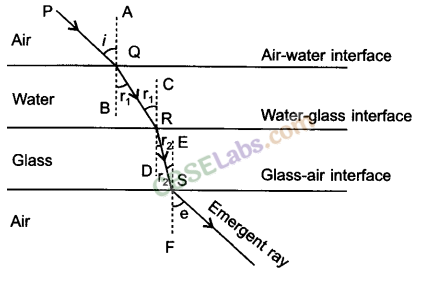
Question 2. A pencil when dipped in water in a glass tumbler appears to be bent at the interface of air and water. Will the pencil appears to be bent to the same extent, if instead of water we use liquids like, kerosene or turpentine. Support your answer with reason.
Answer.
No, it will depend on the refractive index of the liquid in which the pencil is dipped. The tip at the bottom will get elevated as per the relation.

Question 3. Refractive index of diamond with respect to glass is 1.6 and absolute refractive index of glass is 1.5. Find out the absolute refractive index of diamond.
Answer.
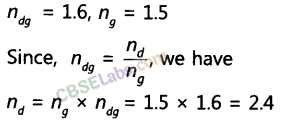
Question 4. A convex lens of focal length 20 cm can produce a magnified virtual as well as real image. Is this a correct statement? If yes, where shall the object be placed in each case for obtaining these images?
Answer.
Yes, for getting virtual image the object has to be placed between the optical centre and the focus. For real and enlarged image, the object should be placed between F and 2F.
Question 5. Under what condition in an arrangement of two plane mirrors, incident ray and reflected ray will always be parallel to each other, whatever may be angle of incidence. Show the same with the help of diagram.
Answer.
When the two mirrors are placed at 90° to each other, the incident and the reflected rays will remain parallel to each other.
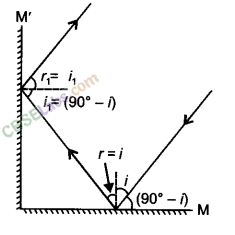
Long Answer Questions
Question 6. Draw ray diagrams showing the image formation by a convex mirror when an object is placed
(a) at infinity
(b) at finite distance from the mirror
Answer.
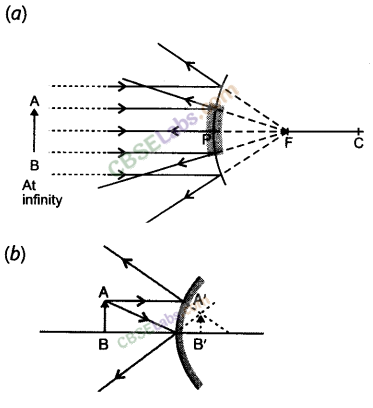
Question 7. The image of a candle flame formed by a lens is obtained on a screen placed on the other side of the lens. If the image is three times the size of the flame and the distance between lens and image is 80 cm, at what distance should the candle be placed from the lens? What is the nature of the image at a distance of 80 cm and the lens?
Answer.
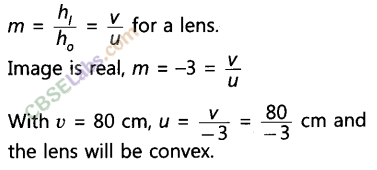
Question 8. Define power of a lens. What is its unit? One student uses a lens of focal length 50 cm and another of -50 cm. What is the nature of the lens and its power used by each of them?
Answer.
Power of a lens: The ability of a lens to converge or diverge the light rays is called power (P) of the lens. It is defined as the reciprocal of the focal length, i.e. f = 1/f .The SI unit of power of a lens is dioptre (D). A lens of focal length 100 cm has a power of 1 dioptre, i.e. 1 dioptre = 1 m
-1
. The lens of focal length +50 cm has a power of +2 D and is convex while the other is having a power of -2 D and is concave.
NCERT Exemplar Class 10 Science Solutions
- Chapter 1 Chemical Reactions and Equations
- Chapter 2 Acids Bases and Salts
- Chapter 3 Metals and Non-metals
- Chapter 4 Carbon and its Compounds
- Chapter 5 Periodic Classification of Elements
- Chapter 6 Life Processes
- Chapter 7 Control and Coordination
- Chapter 8 How do Organisms Reproduce
- Chapter 9 Heredity and Evolution
- Chapter 10 Light Reflection and Refraction
- Chapter 11 Human Eye and Colourful World
- Chapter 12 Electricity
- Chapter 13 Magnetic Effects of Electric Current
- Chapter 14 Sources of Energy
- Chapter 15 Our Environment
- Chapter 16 Management of Natural Resources